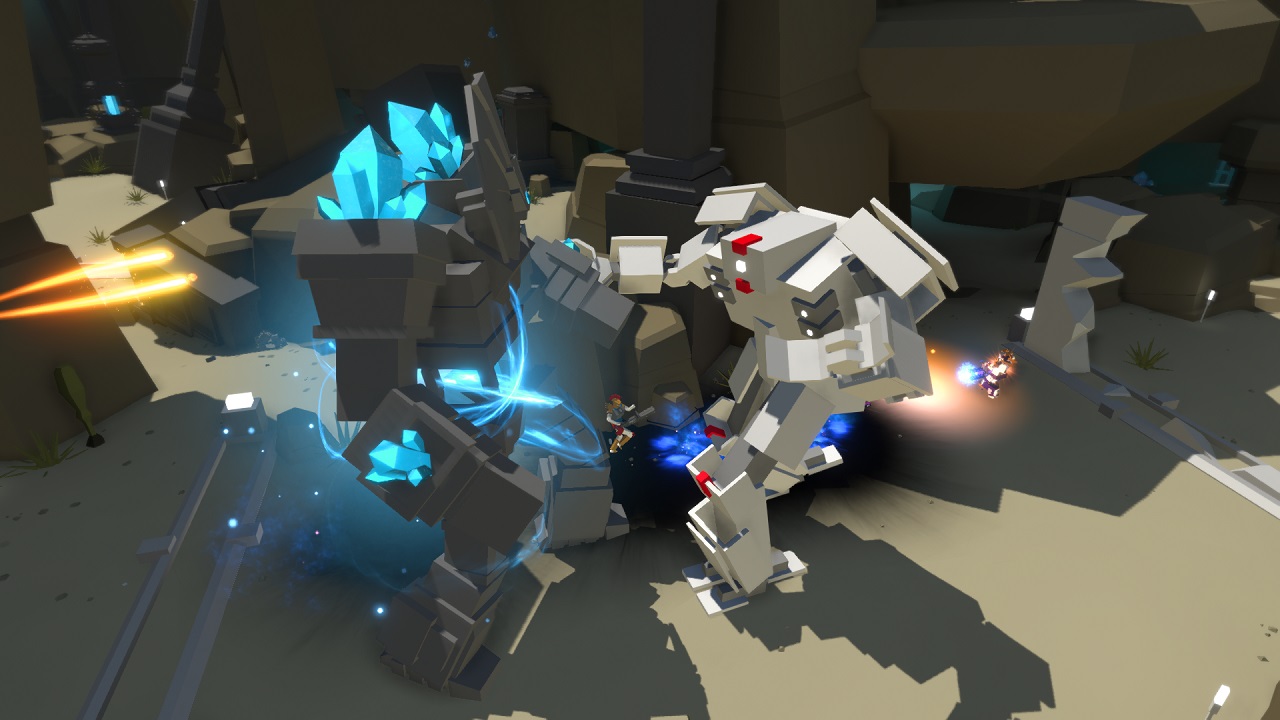In many ways, Minimum is everything that Respawn’s Titanfall is not. Rather than build upon the tried-and-true FPS formula of Call of Duty while adding player-piloted Titans, Minimum instead opts to take its inspiration from modern MOBA (multiplayer online battle arena) games such as League of Legends and DotA 2, combining them with the fast-paced legacy of third-person shooters like Unreal Tournament and Quake, all while featuring AI-piloted Titans.
While not as grand in terms of spectacle as Titanfall, Minimum offers something wholly different in its own with core 5v5 team mechanics, with varying degrees of success. During Early Access, which is currently where the game stands, only one mode is available - Titan Mode, an objective-based match type that focuses on two main components: Creep farming and Titan escorting, with players split into two teams of 5.
Additionally, only limited weapon and armor crafting is available at the moment, which is a core part of the Minimum experience.
Titan Mode matches begin with a Titan escort when the Titans are first spawned. During this phase, the players (on standard red and blue teams) protect their AI-controlled Titans while they duke it out and attempt to support their team’s Titan in the ensuing Titan-brawl.
The second phase of a Titan Mode match is Creep farming, which occurs only after have both teams’ Titans have been destroyed. During this phase, creep nests spawn that randomly generate neutral enemies. When killed, these enemies drop Titan crystals, and collecting them increases the power of your team’s Titan. During this stage players must balance the need to farm and collect creep crystals with the strategic advantage of killing enemy players and disrupting their ability to do the same.
Once the Creep phase ends, the Titans respawn and are as powerful as the team has made them, giving one team’s Titan a clear advantage over the other one. This simple two-step formula repeats until the match ends and one team’s Titan breaks through to the opposing team’s side, cutting off the power supply to the destroyed Titan.
While defending your own giant robot using tried-and-tested third-person shooter mechanics, you must also attack other players - although kill count is not nearly as important as stopping the enemy’s Titan from breaching the walls.
Players are loaded out with pre-made weapon sets that range from machine guns, shotguns, katanas, plasma launchers and everything in between, making the supply of weapons and playstyles varied, although Minimum seems to heavily favor the katana at the moment due to it being ridiculously overpowered. Weapon types don’t seem one hundred percent balanced then, though that’s likely to change over time and is to be expected at this early stage. Nevertheless, the variety of weapons on offer keeps things engaging.
As a reward for killing opponents, you’ll collect upgrade crystals which allow you to improve your chances. Firstly, while obtaining kills, the weapon that scored the kill will level up. For example, a katana kill will spawn a second katana in the off-hand of the player, effectively increasing your damage output by a substantial amount. Further upgrades will increase the damage and speed of the weapon, and give aesthetic differences to the weapons, such as dual flaming katanas. In fact, it’s not uncommon to see a dual-flaming-katana-wielding warrior slaughtering in any given server, which is quite admittedly a difficult level of weapon upgrade to maintain.
These upgrades reset once a player is killed, and must be reacquired by killing more opponents. While this a fun mechanic, the fundamental problem with it is that it allows for the better players to get better while the worse players continue to get slaughtered by the upgraded weapons of their superior foes, thereby essentially feeding into making the more powerful players stronger. While this is a conscious choice by developer Human Head Studios and is a core mechanic of the game, it comes off as a bit unforgiving, especially to players unfamiliar with the arcade shooter genre who will be looking at Minimum with interest.
The second type of upgrade, core to the Minimum experience, is armor upgrades. At the moment, only Knight and Berserker armors are available - with helmets, legs, and chest plates all available to equip separately from each other. These two existing armor types perform much as they would suggest: the Berserker armor increases damage and speed at the expense of health, while the Knight armor does quite the opposite, although mixing and matching is definitely allowed. Once more armors are rolled out and the game goes into a full release, the armor system will likely become more robust; but for now, it’s just a fun aspect of the game without significant depth.
In the final release, enemies will drop blueprints - also obtainable as rewards for in-game achievements - which will allow you to permanently upgrade your weapons or craft deployable items such as turrets, after gathering various crafting resources during each match. You’ll also be able to trade blueprints, items and resources with other players over Steam. Once implemented, this system should see far more depth added to the experience than is currently present, and we look forward to trying it out.
With a minimalistic (get it?) sound track and simple but effective gameplay, Minimum offers a solid arcade shooter experience with clear MOBA elements. While it’s not quite as revolutionary as its trying to be - at least at the moment - the game is ultimately enjoyable for the modest pricetag of $20, although at this stage it’s hard to judge the full extent of the game’s planned content.
Check back for a more comprehensive review of Minimum once the full game launches and the two other game modes and crafting system become playable.
